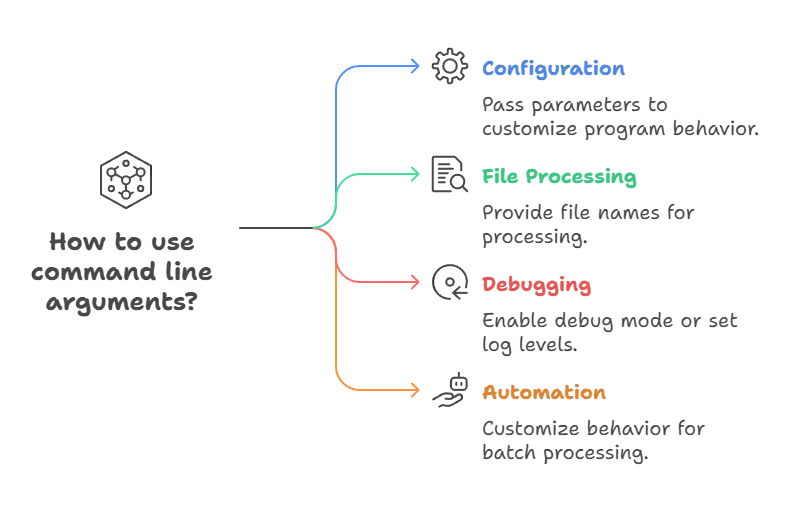Command Line arguments
In C programming, command line arguments provide a way to pass information to a program when it is executed from the command line or terminal. This feature allows users to customize the behavior of the program without modifying its source code. Command line arguments are widely used in various applications, from simple utilities to complex software systems.
When a C program is executed from the command line, the operating system passes arguments to the main function. The main function signature typically looks like this
int main(int argc, char *argv[])
Here, argc stands for “argument count” and argv stands for “argument vector”. argc holds the number of command line arguments passed to the program, and argv is an array of strings containing the actual arguments.
Understanding argc and argv
Let’s dive deeper into argc and argv:
argc: It is an integer value that represents the number of command line arguments passed to the program, including the name of the program itself.argv: It is an array of pointers to strings (char*). Each element ofargvpoints to a null-terminated string that represents one of the command line arguments.
Accessing Command Line Arguments
To access command line arguments, you can iterate over the argv array. Here’s a simple example
#include <stdio.h>
int main(int argc, char *argv[]) {
printf("Total arguments: %d\n", argc);
for (int i = 0; i < argc; i++) {
printf("Argument %d: %s\n", i, argv[i]);
}
return 0;
}
// output //
Total arguments: 3
Argument 0: ./program_name
Argument 1: arg1
Argument 2: arg2
In this example, if the program is executed with the command
./program_name arg1 arg2, argc will be 3, and argv will contain three strings: "./program_name", "arg1", and "arg2".
Use Cases and Examples
Command line arguments are useful in various scenarios:
- Configuration: You can pass configuration parameters to the program.
- File Processing: Provide file names or paths as arguments for file processing.
- Debugging: Enable debug mode or specify log levels.
- Automation: Customize behavior for batch processing or scripting.
Here’s an example demonstrating file processing:
#include <stdio.h>
int main(int argc, char *argv[]) {
if (argc != 2) {
printf("Usage: %s <filename>\n", argv[0]);
return 1;
}
FILE *file = fopen(argv[1], "r");
if (file == NULL) {
printf("Error opening file.\n");
return 1;
}
// File processing code goes here
fclose(file);
return 0;
}
Output
1.If we execute the program without any arguments
$ ./file_processing
Usage: ./file_processing <filename>
2.If we execute the program with a valid filename as an argument, let’s say data.txt
$ ./file_processing data.txt
File opened successfully: data.txt
3.If we execute the program with a non-existent filename:
$ ./file_processing non_existent_file.txt
Error opening file.

In conclusion, command line arguments provide a flexible way to interact with C programs without modifying their source code. Understanding how to use argc and argv allows developers to create versatile and customizable applications. By leveraging command line arguments, programmers can enhance the usability and functionality of their C programs, making them more adaptable to various use cases and environments.Happy coding!❤️
